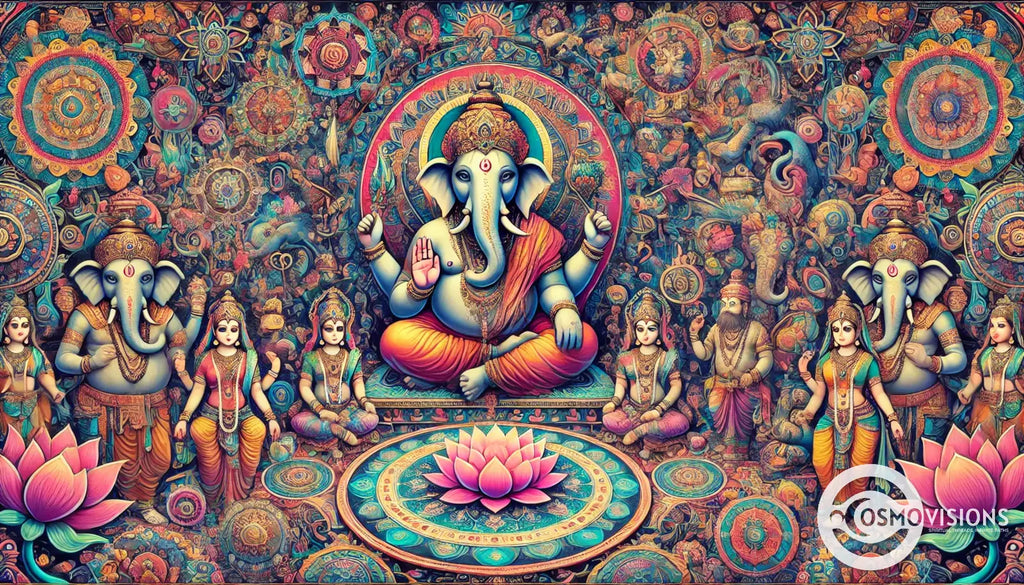Ganesha Puja: Celebrate Ganesh Chaturthi with Ganesh Puja Vidhi
Posted by Massimiliano Geraci

Many people want to celebrate Ganesh Chaturthi at home but aren’t sure how to perform Ganesha Puja correctly. It can be challenging to gather all the essential items and understand the rituals involved.
Did you know that Ganesh Chaturthi, also known as Vinayaka Chaturthi, is one of the most auspicious Hindu festivals dedicated to Lord Ganesha? This festival marks the birth of Lord Ganesha, son of Lord Shiva and Goddess Parvati, bringing blessings of wisdom, prosperity, and removal of various types of obstacles. Various Hindu texts describe how different deities created Ganesha, emphasizing his divine origin and significance. Ganesha's elephant head symbolizes living in harmony with nature, wisdom, and the balance between the physical and spiritual worlds.
Our article offers an easy guide on setting up your altar for Ganesha Puja with a step-by-step process on installing the Ganesh murti (idol), performing shodashopachara Vinayaka Chaturthi puja vidhi (ritual worship), reciting mantras, determining the right puja muhurat (auspicious time) for conducting prayers.
We will also cover how to respectfully conduct visarjan (immersion) after seeking blessings from God during this special occasion. Discover joy in worshiping Ganesha at home. Read on for enlightenment!
How to Set Up an Altar for Ganesha Puja at Home
To set up an altar for Ganesha Puja at home, first, choose a clean and sacred space where you feel a sense of serenity and devotion. The shape of Ganesha's body in iconography is seen as similar to the shape of the sacred mantra 'Om'. Begin by placing a new cloth on the table or platform that will serve as your altar.
This cloth represents purity and welcomes Lord Ganesha’s energy into your home. On this cloth, position the idol of Lord Ganesha, preferably one made of clay to honor traditional practices and environmental consciousness.
Surround the idol with fresh red flowers, symbolizing love and respect for Gajanana. In front of the altar, arrange diyas (lamps) to light during the puja, signifying illumination in both physical and spiritual dimensions. Following this initial setup, add items like prasada (offerings) such as sweets which are beloved by Shri Ganesha. Ensure you have incense sticks ready to burn; their fragrance purifies the environment and assists devotees in focusing their prayers more intently towards seeking blessings from Deva Ganapathi.
Create a rangoli near your altar using vibrant colors; these geometric patterns evoke joyfulness while inviting good fortune into your house during bhadrakshpa month celebrations. Each step taken in preparing this special place should be filled with gratitude towards Divinity for allowing us to celebrate another year under Lord Ganesha’s guidance on his birthday during Chaturthi tithi.

What are the Essential Items Needed for a Ganesh Altar?
Creating a Ganesh altar for Ganesha Chaturthi involves gathering sacred items that honor Lord Ganesha, the elephant-headed god known for being the remover of obstacles. These elements symbolize prosperity, wisdom, and the removal of obstacles in life, embodying the spiritual essence of the festival.
1. Ganesha Murti (Idol): The central figure of any Ganesh altar, crafted from clay or turmeric. This embodies the form of Ganesha to receive prayers and offerings.
2. Clean Cloth: Use this to cover or place beneath the idol, symbolizing purity and respect towards Lord Ganesha.
3. Flowers: Marigolds and lotuses are most suitable, representing prosperity and purity. Place these at the base or around the idol as offerings.
4. Modakas: These sweet dumplings are considered to be Ganesha’s favorite food, used as prasad or divine offering during puja.
5. Durva Grass: Offering 21 blades of Durva grass is essential, signifying health and well-being. It holds special significance in Ganesh worship.
6. Incense Sticks: They create a serene atmosphere conducive to worship, inviting spirituality into the home.
7. Diya (Oil Lamp): Lighting a diya signifies dispelling darkness with knowledge and enlightenment, crucial for any puja.
8. Sandalwood Paste: Apply it on the idol for cooling effects and fragrance, representing clarity and calmness of mind.
9. Fruits: Offerings of fresh fruits symbolize abundance and health bestowed upon family members attending the puja.
10. Finely Decorated Aarti Thali (Plate): Comprising flowers, rangoli colors, rice grains (Akshata), coins for Laxmi Puja symbolizing wealth creation.
11. Yantra or Symbolic Items: Encompassing sacred geometrical designs that attract cosmic energies for blessings of intelligence and luck from Lord Ganehsa.
12. Bell: Ringing a bell during aarti dispels negative energy and calls upon divine attention to accept worship.
13. Books like ‘Ganesha Chalisa’ for hymns recitation amplify devotion through their poetic verses honoring Lord Ganesha’s deeds.
Each item carries deep symbolic meanings within Hinduism rituals enhancing spiritual connection with Lord Ganesha during the festival period observed across states and union territories of India in Bhadrapada month according to Hindu calendar – enriching traditions with spirituality, culture, and shared heritage among devotees seeking blessings for auspicious beginnings and removing obstacles in life’s journey.
Step-by-Step Guide to Decorating the Ganesha Altar
After gathering the essential items for the Ganesh altar, the next exciting step is decorating it. This process prepares a sacred space for the puja and invites positivity and spirituality into the home.
1. Cleanse the designated area for the Ganesha altar using purified water mixed with turmeric, symbolizing purity and sanctity.
2. Spread a new red cloth on the platform where you’ll place the Ganesh Murti, as red attracts divine energy and safeguards against negative influences.
3. Place the idol of Lord Ganesha in the center of the altar, ensuring it faces North or East to align with Vedic guidelines. Ganesha's elephant's head symbolizes wisdom and understanding, making it a significant aspect of his divine form.
4. Decorate around the murti with fresh flowers like marigolds and jasmine, signifying prosperity and purity.
5. Hang garlands made of Durva grass around or near the idol because this grass holds special significance in pleasing Lord Ganesha.
6. Lighting a diya (oil lamp) in front of the murti invites divine presence and dispels darkness both literally and metaphorically.
7. Arrange offerings of sweets such as Modak or Laddu since these are considered favorite delicacies of Lord Ganesha.
8. Keep a small bowl filled with Akshata (rice grains mixed with turmeric) ready to use during various rituals, representing abundance and fertility.
9. Set up incense sticks on either side of the altar to purify surroundings and enhance focus during prayers.
10. Position arranged betel leaves (Paan) near deity statuettes; these leaves are traditional offerings that symbolize longevity and satisfaction.
Each step incorporates elements that are deeply embedded in tradition yet vibrant enough to create an inviting atmosphere for worshipers to immerse themselves in devotion and secure blessings from Lord Ganesha during special occasions like Ganesh Chaturthi day.

How to Install the Lord Ganesha Murti Properly
Having adorned the Ganesha altar with great care, the next pivotal step in welcoming Lord Ganesha into your home during Ganesh Chaturthi involves installing the Ganesh Murti correctly. This process, steeped in tradition and spirituality, calls for attention to detail and a deep respect for the customs that have been passed down through generations.
1. Choose an auspicious time (Muhurat) for the installation: Consulting the Hindu calendar, select a shubh muhurat that falls on Ganesh Chaturthi. The right timing aligns with favorable cosmic energies, enhancing the puja’s benefits.
2. Cleanse the area and yourself: Before setting up the idol, clean the house and take a holy bath early in the morning to purify your surroundings and self, preparing both for the divine presence of Lord Ganesha.
3. Place a new cloth on the altar: Spread a fresh piece of red fabric over the platform where you will install the murti. Red symbolizes prosperity and is beloved by Lord Ganesha.
4. Prepare a seat for Ganesha: Fashion a small throne or use an elevated platform covered with rice grains to symbolize fertility and abundance, upon which you will place the idol.
5. Install the idol with its face towards north or east: Direction plays a crucial role; positioning Lord Ganesha facing north or east attracts positive energy and blessings into your home. Shiva decided to fight Ganesha and then restore his life after realizing his mistake.
6. Consecrate the murti using holy water or raw milk: Sprinkle or pour these purifying substances over the idol gently to sanctify it before beginning prayers, emulating traditional rituals from temples. Shiva returned and revived Ganesha with an elephant's head after a confrontation involving Parvati.
7. Decorate with garlands and flowers: Adorn Lord Ganesha’s murti with fresh flower garlands; marigold flowers are particularly auspicious for their bright orange color that signifies success and happiness.
8. Apply turmeric paste and vermilion: Marking the forehead of Ganesh Murti with turmeric paste followed by vermilion powder represents respect, honor, and warm welcomes accorded to deities in Hindu culture.
9. Offer durva grass blades: Present 21 blades of durva grass to Lord Ganesha as they signify longevity, health, and prosperity according to ancient texts revered within Puja (Hinduism).
10. Light lamps and incense sticks: Illuminate your altar with diyas (oil lamps) and commence your puja by lighting incense sticks to create an aura filled with devotion while dispelling negativity from every corner of your home.
Begin chanting mantras softly: Initiate your prayers by softly reciting selected mantras such as “Om Gam Ganapataye Namaha,” inviting Lord Ganesha to accept your offerings and bless your home with his divine presence.
Offer sweets (Modak) specifically prepared for him: Modaks are believed to be favorite sweets of Lord Ganesha; offering them both pleases him and seeks his blessings for wisdom and knowledge.
Each step in creation of installing the Ganesh Murti is imbued with profound spiritual significance that elevates one’s worship during this sacred festival dedicated to seeking wisdom, prosperity, and protection against obstacles from Lord Ganesha himself.
What are the Mantras to Recite During Ganesh Chaturthi Puja?
During Ganesh Chaturthi Puja, devotees recite various sacred mantras to invoke the blessings of Lord Ganesha. Ganesha agreed to be the scribe for Vyasadeva in transcribing the Indian epic The Mahabharata. The “Ganapati Atharvashirsha“ is chanted as it holds immense significance, being an ancient scripture that venerates the hindu god Ganesha.
The sage Vyasa asked Ganesha to serve as his scribe to transcribe the epic poem Mahabharata. This pivotal text hails from the Rigveda and encapsulates the essence of Ganesha’s powers and benevolence. The recitation begins with “Om Ganapataye Namah”, a powerful mantra that establishes a direct connection with the deity, seeking his guidance and removing obstacles from the devotee’s path.
The “Ganesha Gayatri Mantra“ plays a crucial role during puja time; it is believed to illuminate minds by enhancing clarity and granting wisdom. Devotees chant this mantra 108 times using a japa mala to deepen their meditation and focus on Ganesha’s energy.
Reciting names of Lord Ganesha also forms part of the ritual where 21 different names are uttered, each representing distinct aspects of life he oversees. These practices ensure worshippers invite positivity into their homes, making every corner resonate with divine vibrations on this auspicious occasion celebrated in Shukla Paksha of Bhadra month.
Next comes understanding how to perform Shodashopachara Vinayaka Chaturthi Puja Vidhi correctly for maximizing spiritual benefits.
Which Mantras Are Essential for Ganesh Chaturthi?
Ganesha Chaturthi is a pivotal moment where devotees of Lord Ganesha unite to chant mantras and seek his blessings. Mantras hold the power to purify the atmosphere, drawing in positive energy and dispelling negativity.
1. Ganesh Maha Mantra: "Om Gam Ganapataye Namaha" - This mantra is chanted to remove obstacles, bring wisdom, and encourage success. It invokes Lord Ganesha's energy, who is worshipped as the god of beginnings and the remover of obstacles.
2. Ganesha Gayatri Mantra: "Om Ekadantaya Viddhamahe, Vakratundaya Dhimahi, Tanno Danti Prachodayat" - It pays homage to Ganesha's single-tusked appearance and immense wisdom. Practitioners believe this mantra gives clarity of mind and promotes problem-solving skills.
3. Vakratunda Mahakaya: "Vakratunda Mahakaya Surya Koti Samaprabha Nirvighnam Kuru Me Deva Sarva-Karyeshu Sarvada" - A powerful prayer that idolizes Ganesha's large form and seeks his aid in removing hurdles from all endeavors. The phrase "Surya Koti Samaprabha" highlights Lord Ganesha's brilliance that surpasses a million suns.
4. Ganapati Atharvashirsha: Recited during puja rituals, this ancient Sanskrit text celebrates Ganesha’s unique attributes. It emphasizes his role as the supreme leader (Pranav Swaroop) and origin of all knowledge as per Vedas.
5. Jay Ganesh Deva: Commonly sung during Aarti at the conclusion of Puja ceremonies, this bhajan offers praises to Lord Ganesha for blessings on every home with prosperity and wisdom.
6. Sankata Nashana Stotram: Comprising lines that narrate how worshiping Ganesha can eliminate sorrow and difficulties, chanting it is believed to secure protection from woes for its devoted chanters.
7. Bhalachandra Mantra: "Om Shri Bhalachandraya Namaha" - Dedicated specifically to honor Lord Ganesha’s moon crest (Bhalachandra), it evokes peace by acknowledging His calm demeanor amidst adversity.
Each mantra encapsulates different facets of Lord Ganesha's grandeur- from his mightiness to his gentle grace- painting a holistic picture for followers seeking solace under his tutelage during Ganesh Chaturthi.
How to Chant the Mantras Correctly
Chanting mantras during Ganesh Puja awakens spirituality and invites the blessings of Lord Ganesha. Mastering the correct pronunciation and understanding the essence of these sacred chants enriches the spiritual experience.
1. Start by sitting in a comfortable position facing east, as this direction is believed to enhance focus and serenity during Ganesh Chaturthi.
2. Cleanse yourself physically and mentally before initiating the chant to ensure purity of body and soul.
3. Use a prayer bead (mala) made from Rudraksha or Tulsi for counting repetitions without losing concentration.
4. Recite each mantra slowly, clearly, and with devotion, focusing on enunciating every syllable correctly to honor Ganesha and seek his blessings.
5. Begin with “Om Gan Ganapataye Namah,” known as the Moola Mantra, which encapsulates the energy and essence of Lord Ganesha.
6. Follow with specific mantras for Ganesha Chaturthi, such as “Gajananam Bhoota Ganadi Sevitam,” invoking his attributes as the leader of celestial hosts.
7. Include mantras that express gratitude and seek forgiveness for any errors during puja, reinforcing humility and reverence.
8. Conclude your chant following mantra recitation with “Om Shanti,” seeking universal peace and inner tranquility.
9. Incorporate meditation post-mantra chanting to internalize the divine vibrations generated during recitation.
10. Educate oneself continually on the meanings behind mantras to deepen one's spiritual practice.
Focusing on tradition while embracing personal understanding enhances connection with Ganesha during this auspicious festival period, making every chant a step closer to divine bliss.
What are the Benefits of Reciting Mantras to the Elephant Headed God?
Reciting Ganesha mantras during Ganesh Chaturthi puja and beyond brings a plethora of spiritual, mental, and physical benefits. These ancient chants pave the way for removing obstacles from the devotee's path, fostering an environment ripe for success and prosperity.
The vibrational energy generated through mantra recitation aligns one's inner spirit with divine frequencies, promoting clarity of mind human body and soul. This practice not only aids in seeking the blessings of Lord Ganesha but also instills a sense of peace and well-being within the individual.
Mantra recitation transforms mere words into vessels carrying divine energy.
Engaging in this sacred tradition encourages a deep bond between the believer and divinity, facilitating personal growth alongside spiritual enlightenment. It serves as an invaluable tool for those endeavoring to cleanse their aura, achieving higher levels of consciousness and drawing closer to realizing their ultimate life goals.
As individuals immerse themselves in these powerful incantations, they unknowingly contribute to gods creating a harmonious balance between their worldly desires and spiritual duties.
The journey through understanding Ganesha's body mantras enlightens us about their significance in dealing with life's challenges successfully.

How to Perform Shodashopachara Vinayaka Chaturthi Puja Vidhi Correctly
To conduct the Shodashopachara Vinayaka Chaturthi Puja Vidhi accurately, devotees begin by cleansing themselves and their homes to invite purity. This step embodies the essence of preparation for welcoming Lord Ganesha’s presence. Ganesha's quick ascension in the Hindu pantheon and his significance as a widely revered deity highlight his importance in this ritual.
Installation of the idol, known as Ganesh Murti Sthapana, follows - using a clay or turmeric image, reinforcing connections with nature and traditional practices. Worshipers adorn the altar with flowers at the base of the Ganesh idol, setting a radiant stage for devotion.
The ceremony proceeds by offering sixteen services (Shodashopachara) that include welcoming Lord Ganesha into the home (Avahana), seating Him comfortably (Asana), washing His feet (Padya), and hands (Arghya).
Devotees then bathe the idol symbolically with sacred water (Snana), clothe it in new garments (Vastra), and anoint it with sandalwood paste (Gandha). The lighting of lamps (Deepa) dispels darkness while incense sticks spread fragrance, invoking purity in thoughts.
Offerings of food items prepared with care act as Prasad to seek blessings from Lord Ganesha — every ritual performed mirrors deep respect and adoration towards divinity during this auspicious 2024 Ganesh Chaturthi celebration.
What is Shodashopachara Vinayaka Chaturthi Puja Vidhi?
Shodashopachara Vinayaka Chaturthi Puja Vidhi is a traditional ritual performed to honor Lord Ganesh during the Ganesh Chaturthi festival. This ceremony involves sixteen steps of worship, each signifying a particular form of offering and respect towards the presiding deity.
From invoking Lord Ganesha's presence into the idol (Ganesha Murti Sthapana) to circumambulating from left to right, every step is imbued with deep spiritual meaning and devotion. Devotees clean their homes thoroughly, prepare a puja room, and decorate the image of Ganesh with flowers and garlands.
The process reflects devotees' commitment to seeking blessings for wisdom, prosperity, and success.
Devotees use items they already have in their puja collection or procure new images specifically for this occasion. This includes using clay or turmeric idols and temples that symbolize environmental consciousness alongside spirituality.
Each action within the vidhi — from offering modakas as prasad to chanting sacred mantras — serves to deepen one's connection with divine energies and reinforce communal harmony during this auspicious period known as Shodashopachara.
The next aspect guides enthusiasts through a step-by-step procedure for performing the Puju Vidhi accurately.
Step-by-Step Procedure for Performing the Puja Vidhi
Ganesha Chaturthi is celebrated with deep fervor and careful preparation, marking a period where devotees seek the blessings of Lord Ganesha. The Shodashopachara Vinayaka Chaturthi Puja Vidhi embodies a series of steps designed to honor the deity, ensuring the observance fulfills both spiritual and traditional protocols.
1. Clean the house and make sure your puja room or designated space exudes purity and tranquility, setting an apt stage for inviting Lord Ganesha into your home.
2. Install the idol of Ganesha on a clean altar, preferably facing North or East, symbolizing auspicious beginnings and removing obstacles.
3. Begin the puja at the right muhurat, which often falls during Madhyahna (midday), as per Hindu belief that Lord Ganesh was born during this time.
4. Invoke Lord Ganesha by chanting the Vighneshwara Mantra to invite His presence into the idol, preparing for the main puja ceremonies.
5. Offer 21 blades of Durva grass, a favorite of Lord Ganesha, signifying health and prosperity.
6. Place modakas (sweet dumplings) as prasad before the idol, embodying a gesture of offering food to please Him.
7. Perform Arti with friends and family gathered around, circulating an oil lamp in front of the deity while singing or playing devotional songs dedicated to Lord Ganesh.
8. Circumambulate from left to right around the altar reverently, embodying respect and devotion towards Lord Ganesh.
9. Recite specific mantras such as "Om Gan Ganapataye Namah" 108 times using a japa mala (prayer beads), focusing on His various attributes for blessings in wisdom and prosperity.
10. Heal any past grievances or forgetfulness by seeking forgiveness through heartfelt prayers; this reaffirms one's faith and devotion while rectifying lapses in worship.
11. Conclude with requesting permission from Lord Ganesh to formally end the Puja vidhi through chanting and then quietly reflecting on His teachings.
Every step in this process deepens one's spiritual journey and strengthens bonds within community members coming together to celebrate this auspicious festival.
Common Mistakes to Avoid During the Puja Vidhi
Moving from learning the step-by-step procedure for performing the Puja Vidhi, it's crucial to also understand common pitfalls. This awareness ensures that devotees conduct the Ganesha Chaturthi Puja with reverence and attention to detail, aligning closely with tradition and religious prescriptions.
1. Skipping the purification rituals: Ignoring the initial steps of purifying oneself and the surroundings can adversely affect the sanctity and effectiveness of the pooja. Devotees should use sacred water for purification purposes.
2. Incorrect placement of idols: Placing Lord Ganesha's idol in an inappropriate direction can hinder divine blessings. The idol should face North or East, ensuring a conducive flow of spiritual energy.
3. Neglecting to offer fresh flowers: Flowers symbolize purity and devotion; hence, offering stale or wilted flowers during pooja disrespects divine energy. Devotees must opt for fresh blooms to honor deity Ganesha.
4. Using incorrect mantras: Reciting mantras inaccurately or opting for inappropriate ones can disrupt the puja's energy flow. It’s vital to learn and chant specific Ganesha Chaturthi Mantras correctly.
5. Inadequate offerings (Naivedya): Offering insufficient or inappropriate food items fails to satisfy ritualistic requirements. Traditionally, modakams (sweet dumplings) are preferred as they are believed to be Lord Ganesha's favorite.
6. Overlooking the timing (Muhurat): Conducting pooja outside of the auspicious time frame minimizes its effectiveness. Devotees should plan to perform rituals at the correct Muhurat according to Hindu calendar Bhadra.
7. Not involving family members: The essence of Ganesh Chaturthi rests on collective celebration and prayer. Excluding family members from participating dilutes communal blessings and shared spiritual enrichment.
8. Forgetting post-puja practices: After completing Ganesh Pooja, many overlook Aarti or neglect immersion protocols (Visarjan). Properly concluding ceremonies through Aarti and performing Visarjan respectfully are integral parts of worship that ensure cycle completion.
9. Installing multiple idols without understanding their significance may lead to disruptions in worship focus; one idol suffices for fulfilling traditional rites efficiently while upholding profound respect towards divine representations ensconced within religious narratives embedded in Puranas and reflected through educational discourses on spirituality.
10. Failing to observe silence during mantra recitation diminishes concentration levels, affecting pooja's serene ambiance necessary for invoking divine presence effectively amidst chants echoing deep-rooted reverence inherited from ancient Vedic traditions spanning Kerala's lush landscapes to Ellora Caves' architectural grandeur revealing centuries-old devotion trails traversed by seekers yearning for spiritual awakening through disciplined religious observances highlighted during Ganesh Chaturthi festivities celebrated across diverse cultures marking a period replete with devout gatherings echoing unified hymns venerating deity Ganesha’s arrival signifying auspicious beginnings relentlessly pursued amidst life’s perennial quest towards attaining transcendental bliss transcending temporal existence enveloped within mortal confines striving against ceaseless challenges besetting paths tread upon by countless souls seeking solace under benevolent watchfulness evinced through divinity’s omnipresent gaze manifesting across ethereal dimensions bridging celestial abodes with earthly domains where faith intertwines destinies shaping existential narratives propelled by inherent desires nurturing hopes enkindling hearts aflame with devotion immortally bound unto eternity’s embrace encapsulating essences distilled through timeless ceremonies rever.
What is the Right Muhurat for Ganesha Chaturthi Puja?
Selecting the right deity and muhurat for Ganesha Chaturthi puja holds deep spiritual and cultural significance, ensuring that prayers and rituals align with auspicious timing to invoke the blessings of Lord Ganesh. In Hindu texts, Ganesha is revered as the remover of obstacles and the guardian of esoteric knowledge, highlighting his essential role in spiritual practices.
Experts in Hindu astrology chart the muhurat based on lunar positions, typically avoiding Bhadra (Hindu calendar) to welcome Lord Ganesh into their homes. This period marks a time when divine forces are believed to be most receptive to prayers, enhancing the festivity’s impact on devotees’ lives.
The ideal muhurat usually falls in the mid-morning, as this tenth day is considered highly propitious for performing rites and offering veneration.
During Ganesh Chaturthi, adhering to this carefully selected muhurat signifies respect for tradition while seeking favor from Shri Ganesh. Families gather together during this hallowed time frame, using traditional puja altars adorned with sacred items essential for worship - including idols made with reverence and devotion to various gods.
The collective spirit of faith across communities transforms individual prayer into a powerful societal bond, further enriching the festival’s communal experience. The right Muhurat elevates Ganesha Chaturthi Puja from mere ritual to profound communion with divinity.
How to Determine the Puja Muhurat?
Determining the Puja Muhurat for Ganesha Chaturthi involves aligning oneself with cosmic timings that enhance the spiritual significance of the rituals. The right Muhurat ensures that prayers and offerings reach Lord Ganesh, amplifying the festival's blessings.
1. Consult the Hindu calendar (Panchang) to identify the fourth day (Chaturthi) of the lunar month Bhadrapada, marking the arrival of Ganesh Chaturthi. This period generally falls between late August and early September.
2. Look out for timings when the tide of cosmic energy is strong, usually during Madhyahna Kala, which is the midday according to Vedic astrology. This time frame is considered to be most auspicious for Ganesha Puja as it symbolizes Ganesha's birth hour.
3. Avoid times when Durmuhurtam occurs – a short period that recurs every day considered inauspicious for starting any new activity – ensuring that your puja avoids these intervals.
4. Prioritize Tithis that are dedicated to Lord Ganesh; Chaturthi Tithi is particularly favored for invoking his presence and blessings during Ganesh Chaturthi celebrations.
5. Check for Vinchudo periods, which can restrict certain activities including puja and should be avoided to ensure uninterrupted spiritual connections during worship.
6. Engage with experienced priests or astrologers who specialize in calculating precise Muhurats based on complex astrological charts, saving time for those planning the puja together and seeking his blessings.
7. Align the Puja with local traditions as practices might slightly differ from region to region; understanding nuanced differences respects cultural diversity while celebrating unity in worship.
8. Utilize digital platforms or apps to calculate accurate Puja Muhurats specific to individual locations; this modern approach complements traditional methods by accommodating geographic variations in time calculation.
9. Consider conducting Parikrama or Pradakshina around your home or temple after completing the Ganesha Puja at an auspicious time, enhancing positive vibrations within the space.
10. Acknowledge Ananta Chaturdashi as an ideal conclusion day for Ganesh Visarjan rituals; selecting a good Muhurat on this day maximizes benefits obtained from Ganesha’s stay.
Incorporating these steps when determining the right time for Ganesha Puja invites divine energies into one’s life, allowing worshippers to fully immerse in spirituality and seek profound blessings from Lord Ganesh during this vibrant festival.
Best Time for Ganesha Puja During Ganesh Chaturthi
Identifying the optimal moment for Ganesha Puja during Ganesh Chaturthi involves a precise understanding of the puja muhurat. This period is not just any time slot but a sacred window, deeply rooted in Vedic astrology, marked by its auspiciousness for invoking Lord Ganesha's blessings.
Traditionally, the fourth day of Bhadrapada month’s bright half is earmarked for this celebration, aligning with beliefs central to Hinduism and echoed in practices across regions from Pune to Goa.
The right of Shri Ganesha to be worshipped first before any other deity underscores the significance of choosing an auspicious time, ensuring that devotees can maximize their spiritual benefits.
The muhurat typically spans over two hours and 24 minutes—often occurring at midday. For those engaged in the careful rituals comprising ganesh chaturthi puja vidhi, this timeframe demands acute attention.
Devotees look towards this phase as a golden opportunity to conduct prayers and procedures with utmost sanctity. By engaging in puja at this sacrosanct juncture, individuals unite under a common goal: seeking blessings for wisdom and prosperity from Lord Ganesh.
This shared cultural moment transcends mere religious observance; it becomes an embodiment of collective spirituality experienced through age-old traditions preserved within communities ardently following Hindu customs such as Arti (Hinduism) and Vrata among others.
Importance of Observing the Correct Muhurat
The selection of the correct Muhurat, or auspicious time, for Ganesha Chaturthi Puja plays a pivotal role in harnessing the spiritual energy and blessings associated with this sacred festival.
Observing the Muhurat brings alignment between celestial forces and human endeavors, maximizing the flow of positive energy toward those participating in puja for Lord Ganesh. This harmonization uplifts the spiritual ambiance and ensures that devotees’ prayers are more likely to be heard and granted by Lord Ganesha, revered as the remover of obstacles and harbinger of prosperity.
Choosing this moment with care involves consulting ancient Vedic texts and calendars to pinpoint when cosmic vibrations favor human actions. During Ganesh Chaturthi, such precision allows individuals to conduct rituals at a time when divine presence is most accessible, deeply influencing outcomes related to wisdom, wealth, and wellbeing.
The careful observation of these timings underscores a profound intersection between spirituality and astronomy—an embodiment of India's rich cultural heritage where religious practices are intricately linked with cosmic rhythms.
The right Muhurat acts as a bridge between the divine and us.
How to Conduct the Visarjan (Immersion) of the Ganesh Idol
Choose an eco-friendly Ganesh idol made of natural clay for the Visarjan. This practice respects both religious traditions and environmental concerns, aligning with the spiritual significance of Ganesh Chaturthi. The mouse as Ganesha's vehicle became prominent in sculptures during the 7th century in central and western India, highlighting its importance in the region's religious art.
Perform a final Aarti near a body of water to invoke the goddess’ blessings and signify the deity’s return journey, embodying the cycle of birth and rebirth inherent in Hindu philosophy.
Immerse the idol gently into the water, ensuring it is fully submerged. This act symbolizes releasing Lord Ganesha’s body back to Mount Kailasha to join his parents, Shiva and Parvati, marking a respectful farewell after days of festive worship.
The immersion transforms from mere tradition into a poignant reminder of life’s impermanence and our interconnectedness with nature’s cycles.

What are the Rituals Involved in Ganesh Visarjan?
Ganesh Visarjan marks the culmination of Ganesh Chaturthi, symbolizing Lord Ganesha's return to Mount Kailasa to join his parents, the gods Shiva and Parvati. This ritual embodies the cyclical nature of birth and dissolution in the universe, resonating deeply with the principles of anthropology, spirituality, and Indios art lovers. Here are the key rituals involved:
1. Perform the Aarti: Devotees gather to perform one final aarti for Ganesha before the procession begins. This act is a sacred fire ritual where lamps are lit and songs are sung in praise of Lord Ganesha.
2. Offer Prayers: Participants offer prayers and chant mantras, invoking Ganesha's blessings for prosperity and happiness. The mantra "Om Gan Ganapataye Namah" is commonly recited during this time.
3. Prepare the Idol: Before the procession, devotees gently bathe the idol with clean water or milk. This purification ritual signifies cleansing oneself of worldly impurities.
4. Apply Vermilion Paste: Devotees adorn the idol with fresh vermilion paste, symbolizing respect and honor towards Ganesha as they prepare him for his journey back to Kailasa.
5. Garland the Idol: The idol is then garlanded with flowers, indicating reverence and adoration for Lord Ganesha.
6. Begin the Procession: The idol is carried in a procession amidst chants and devotional music towards its immersion point. This procession represents Lord Kartikeya leading a baraat (wedding procession) as per wedding customs by country.
7. Stop at Water Body: Typically at a river, lake or sea, devotees pause, reflecting on life's transient nature while preparing to bid farewell.
8. Perform Immersion: Carefully immersing the idol into water symbolizes Ganesha’s departure from Earth back to his celestial home, also illustrating life's cycles from birth through dissolution.
9. Share Sweets: Post-immersion, devotees distribute sweets such as modak believing that distributing sweets will impart joy and well-being among community members.
10. Depart in Silence: Leaving the immersion site quietly signifies respect for all elements involved in Ganesh Chaturthi festivities while contemplating on lessons learned during this spiritual journey.
How to Safely and Respectfully Conduct the Visarjan
Conducting the Visarjan of a Ganesh idol marks the culmination of Ganesha Chaturthi, symbolizing the cycle of birth and rebirth. This act embodies deep spiritual meaning, resonating with devotees' prayers for wisdom, prosperity, and obstacle removal.
1. Choose an eco-friendly Ganesh idol to support environmental preservation. Using idols made from natural clay or biodegradable materials reduces pollution and harm to aquatic life.
2. Cleanse the area around your home or the immersion site with holy water to purify it before beginning the Visarjan rituals.
3. Perform a final Aarti at home with family members gathered to bid farewell to Lord Ganesha. This ritual involves lighting camphor or lamps and circulating them in front of the idol while chanting mantras one considers sacred.
4. Wrap the Ganesh idol gently with a clean cloth if it is not too large; this respects the deity's form as you prepare for immersion.
5. Carry the idol respectfully to the immersion site. Processions should be peaceful, reflecting devotion and respect rather than causing disruption.
6. Before immersing the idol, offer coconuts, flowers, and sweets into the water as offerings to Ganesha and other elements in nature embodying divine presence.
7. Immersion should be undertaken during daylight hours to ensure safety and align with traditional timings observed by most households during Ganesh Chaturthi.
8. Lower the Ganesh idol slowly into water, allowing it to immerse completely. This symbolizes Lord Ganesha's return to Mount Kailasa, joining his parents God Shiva and Goddess Parvathi.
9. Recite prayers or sing hymns begging forgiveness for any unintentional disrespect or errors during worship and requesting Lord Ganesha's blessings for all endeavors until his next advent.
Moving forward beyond Visarjan rituals enriches our understanding of how Ganesha Chaturthi encapsulates themes of renewal, ethical conduct, and ecological responsibility within its celebratory practices.
Significance of Visarjan in Ganesh Chaturthi Festival
Visarjan marks the culmination of Ganesh Chaturthi, symbolizing Ganesha's return to Mount Kailash to join his parents, Shiva and Parvati. This ritual embodies the cycle of creation and dissolution in Hindu philosophy, illustrating that everything material must eventually merge back into the universal source.
Through visarjan, devotees express their respect for this cosmic truth, releasing the deity's physical form and embodiment back into mother nature. It serves as a poignant reminder of impermanence, urging individuals to detach from earthly ties.
The practice also fosters communal harmony and collective spiritual awakening. By immersing idols crafted for worship during Ganesh Chaturthi in bodies of water, participants unite in a shared act of devotion across diverse communities.
Such rituals emphasize coexistence with nature by using biodegradable materials like clay for idol making—a tradition inspired by eco-spiritual sensibilities rooted deeply within religion itself.
Visarjan thus transcends mere religious observance; it becomes a powerful act witnessing spirituality interwoven with environmental consciousness, resonating profoundly within anthropological and art circles alike.






























